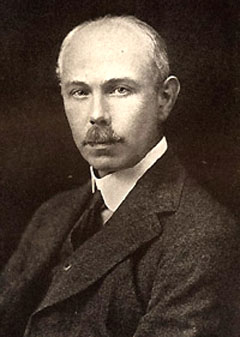| Francis W. Aston  AKA Francis William Aston AKA Francis William Aston
Born: 1-Sep-1877
Birthplace: Harborne, Birmingham, England
Died: 20-Nov-1945
Location of death: Cambridge, Cambridgeshire, England
Cause of death: unspecified
Gender: Male
Race or Ethnicity: White
Occupation: Chemist, Physicist Nationality: England
Executive summary: Invented the mass spectograph Military service: Royal Aircraft Establishment (1914-18) British scientist Francis W. Aston won the Nobel Prize for Chemistry in 1922, for his 1919 invention of the mass spectrograph, a new type of positive-ray apparatus which uses magnetic and electrostatic fields producing opposite deflections in the same plane to convert molecules into ions, then sorts the ions by to their mass-to-charge ratio. The mass spectroscope proved the existence of isotopes, allowed study of nuclear masses with great precision, and helped lay the foundation for the atomic energy and weaponry. Aston himself used the device to identify 212 isotopes. In 1920 he formulated the "whole number rule", using the existence of isotopes to revive a hypothesis by WilliamProut (1785-1850), that all atoms are aggregations of hydrogen atoms.
After earning his degree in Chemistry at the University of Birmingham in 1898, he worked for several years at a local brewery and pursued chemistry experiments in a small laboratory in his home. He later worked as an assistant to J. J. Thomson, who discovered the electron. He also studied the cause of a dark region visible in glow-discharge tubes under cathode glow, which has come to be known as the Aston Dark Space since publication of his findings in 1911. Aston never married, and for most of his adult life his closest companion was his sister Helen. Father: William Aston (farmer and metal merchant, d. 1908)
Mother: Fanny Charlotte Hollis Aston
Sister: Helen Aston (b. 1890)
Sister: Mary Aston
High School: Harborne Vicarage School, Worcestershire, England (1891)
High School: Malvern College, Worcestershire, England (1893)
University: BS Chemistry, University of Birmingham (1898)
Scholar: Chemistry, University of Birmingham (1898-1900)
Scholar: Chemistry, University of Birmingham (1903-09)
Lecturer: Chemistry, University of Birmingham (1909-10)
Scholar: Cavedish Laboratory, Cambridge University (1910-14)
Scholar: Cavedish Laboratory, Cambridge University (1914-45)
Fellow: Trinity College, Cambridge University (1919-45)
W. Butler & Co. Brewery Employee (1900-03)
Mackenzie Davidson Medal 1920
Royal Society 1921
Nobel Prize for Chemistry 1922
Hughes Medal 1922
John Scott Medal 1923
Emanuele Paterṇ Medal 1923
Accademia dei Lincei 1926
Royal Medal 1938
IOP Duddell Medal 1941
Athenaeum Club (London)
Royal Institute of Chemistry
Russian Academy of Sciences Foreign Member
English Ancestry
Lunar Crater Aston (32.9° N 87.7° W, 43 km. diameter)
Author of books:
Isotopes (1922)
Structural Units of the Material Universe (1923)
Mass Spectra and Isotopes (1933)
Requires Flash 7+ and Javascript.
Do you know something we don't?
Submit a correction or make a comment about this profile
Copyright ©2019 Soylent Communications
|